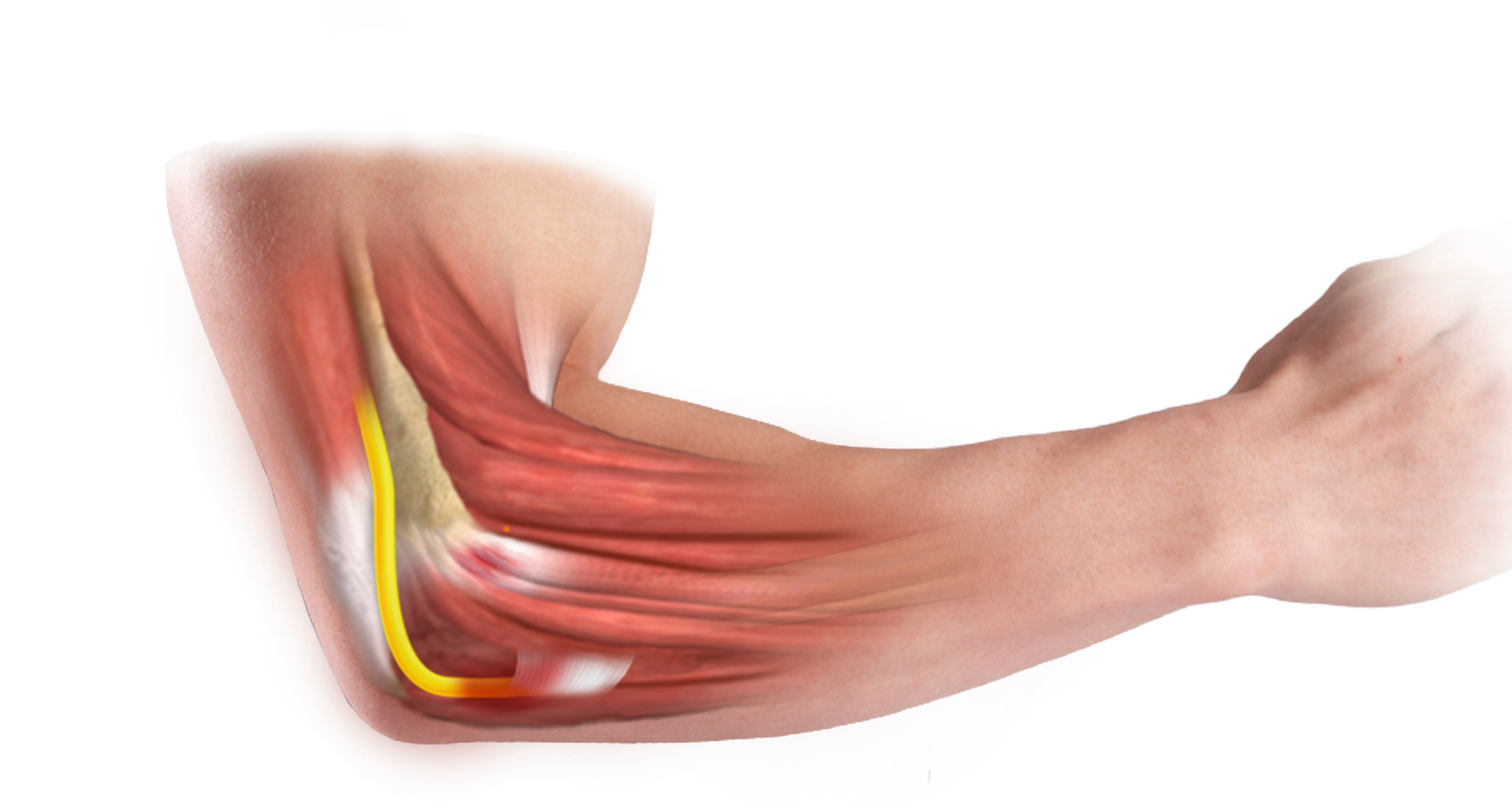Cubital Tunnel Syndrome
Cubital tunnel syndrome, also called ulnar nerve entrapment is a condition caused by compression of the ulnar nerve in an area of the elbow called the cubital tunnel. The ulnar nerve travels down the back of the elbow behind the bony bump called the medial epicondyle & through a passageway called the cubital tunnel. The cubital tunnel is a narrow passageway on the inside of the elbow formed by bone, muscle, & ligaments with the ulnar nerve passing through its centre. The roof of the cubital tunnel is covered with soft tissue called fascia. When the elbow is bent, the ulnar nerve can stretch & catch on the bony bump. When the ulnar nerve is compressed or entrapped, the nerve can tear & become inflamed leading to various symptoms


What are the signs & symptoms?
Signs & symptoms of cubital tunnel syndrome usually occur gradually, progressing to the point where the patient seeks medical attention. Left untreated, cubital tunnel syndrome can lead to permanent nerve damage in the hand. Commonly reported symptoms associated with cubital tunnel syndrome include intermittent numbness, tingling, & pain to the little finger, ring finger, & the inside of the hand. These symptoms occur more frequently at night, & with elbow bending or prolonged resting on the elbow.
What are the causes?
Injury to the elbow such as fractures, dislocations, or a direct blow can cause tissue swelling which can compress the ulnar nerve within the cubital tunnel. Individuals who perform repetitive elbow flexion movements at work or play are believed to be at high risk for developing cubital tunnel syndrome. Repeatedly bending & straightening the elbow can irritate & inflame the ulnar nerve. Leaning on the elbow for extended periods of time such as when working at a desk can also cause ulnar nerve irritation. Bone spurs, ganglion cysts, or tumours can form in the cubital tunnel leading to pressure & irritation of the ulnar nerve.
Your physician will recommend conservative treatment options initially to treat the cubital tunnel syndrome symptoms unless muscle wasting or nerve damage is present. Conservative treatment options may include wearing a brace or splint at night while sleeping to keep the elbow in a straight position. You can also wrap the arm loosely with a towel & apply tape to hold it in place. If conservative treatment options fail to resolve the condition or if muscle wasting or severe nerve compression is present, your surgeon may recommend you undergo a surgical procedure to treat Cubital Tunnel Syndrome.
Different surgeries are performed to treat your condition.
- Medial Epicondylectomy: This surgery involves removing the medial epicondyle, the bony bump on the inside of the elbow, enabling the ulnar nerve to glide smoothly when the elbow is flexed & straightened
- Ulnar Nerve Transposition: This surgery involves creating a new tunnel in front of the medial epicondyle & transposing (moving) the ulnar nerve to the new tunnel
Your surgeon will decide which surgery would be best for you depending on your condition. How is the surgery performed?
If your nerve compression is mild your surgeon may recommend a medial epicondylectomy. In this procedure your surgeon will make an incision over the medial epicondyle, the bony bump on the inside of the elbow. The cubital tunnel is cut open through the soft tissue roof exposing the ulnar nerve. The forearm muscles or flexor muscles are cut & detached from the epicondyle. Using special instruments, your surgeon will shave away the bump, freeing the ulnar nerve to glide smoothly within the cubital tunnel without pressure from the bump. The flexor muscles are then reattached to the area of shaved bone with special sutures. The incision is then closed with sutures & covered with a dressing.
More commonly, your surgeon may recommend an ulnar nerve transposition. Your surgeon will make an incision over the medial epicondyle. The cubital tunnel is cut open through the soft tissue roof exposing the ulnar nerve. The forearm muscles or flexor muscles are cut & detached from the epicondyle. The ulnar nerve is transposed or moved from behind the elbow to a new location in front of the elbow. The ulnar nerve may be placed above the flexor muscle, within the muscle, or under the muscle. Your surgeon will decide which option is best for you. The flexor muscles are then sutured back together & reattached with special sutures to the Epicondyle. The incision is then closed with sutures & covered with a dressing.
What are the risks & complications?
The majority of patients suffer no complications following cubital tunnel surgery. However, complications can occur following elbow surgery & include:
- Infection
- Nerve damage causing permanent areas of numbness around the elbow or forearm
- Elbow instability
- Elbow flexion contracture
- Pain at site of scar
- Symptoms are not improved by the surgery









